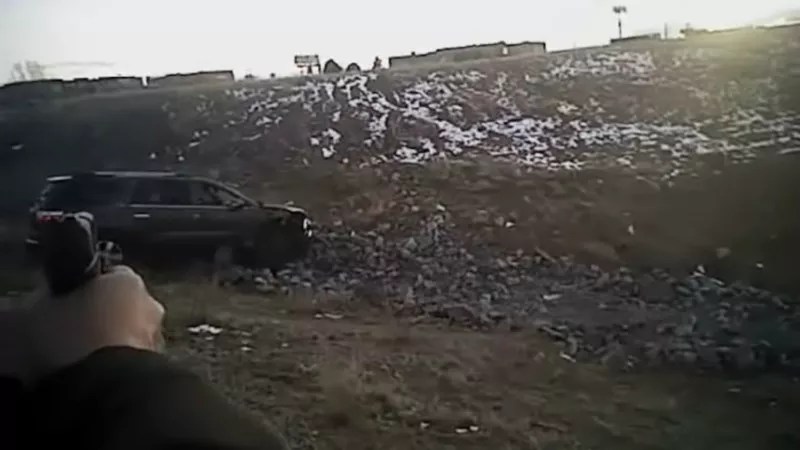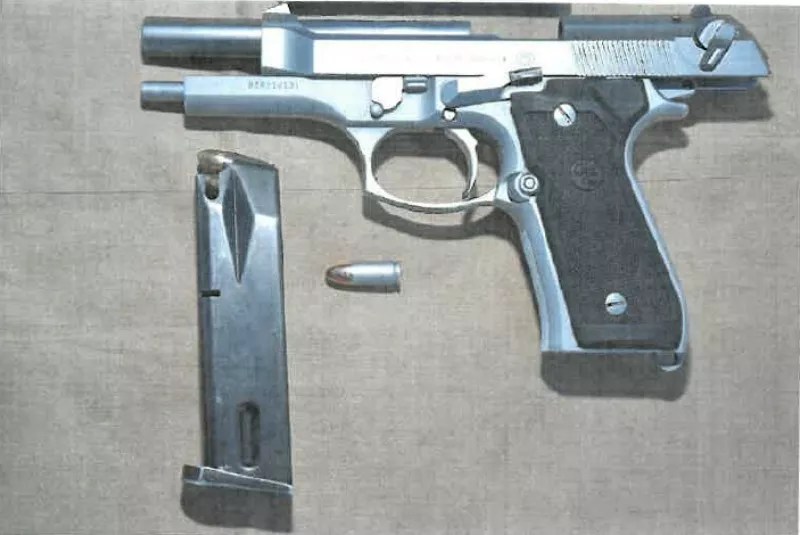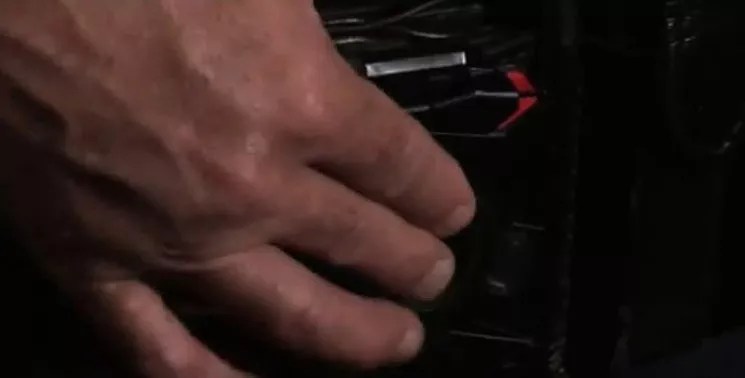
Denver Police Department via YouTube

Audio By Carbonatix
The video showing the fatal shooting of Steven Nguyen by three Denver police officers is disturbing in the extreme, and after watching it, many viewers will question whether the gun-down was necessary even though Denver District Attorney Beth McCann has determined that it was legally justified.
But the footage is important beyond the facts of the case. The twelve-plus minutes’ worth of images captured by the officers’ body cameras are the first to be released under the Denver Department of Safety’s new video-evidence policy, which allowed them to be made available publicly before an internal investigation of the officers’ actions has been completed.
The new policy, as well as the video and DA McCann’s decision letter explaining why the officers won’t be criminally charged, are on view below – and while the rules sped up the distribution of the clip in this instance, they don’t mandate a release within a set period of time, as do cities such as Chicago, whose procedures set a sixty-day limit, with provisions for an additional thirty-day extension. Indeed, Nguyen died on March 19, just shy of seven months ago. And neither do they call for all available video to be put out. The Nguyen video has been edited to remove what Mary Dulacki, the records administrator for the Department of Safety, describes as “segments that would have identified undercover officers or unmarked police vehicles.”
What remains is still controversial, much like the incident as a whole. Police were searching for Mauricio Venzor-Gonzalez, an attempted murder suspect who escaped while at Denver Health, but members of the department’s fugitive unit mistakenly identified Nguyen as their quarry. That led to a police pursuit of Nguyen and Rafael Landeros Jr., who was injured in the subsequent shooting but survived. The chase ended when the vehicle Landeros was piloting skidded off the pavement along the 4100 block of Albion Street. Moments later, three DPD officers – Austin Barela, William Bohm and Susan Mercado – opened fire after they claimed to see the men trying to grab a weapon.
Turns out there was a handgun in the car – a 9mm Beretta. Moreover, both Nguyen and Landeros had active warrants in their name. But the video doesn’t offer definitive proof that the cops had no choice other than to pull their respective triggers when they did.
Here’s the video, which may disturb some readers.
In the past, Denver officials might have held back the video until after their own inquiry had wrapped. That we’re already able to see it reflects the development of the video-evidence policy.
“We’ve been talking about it for a long time in this office,” the Department of Safety’s Dulacki says. “We’ve recognized that we have more and more video footage, whether it’s from body-worn cameras or surveillance cameras owned by the city or surveillance cameras in the jail or privately owned surveillance cameras. And the public has expectations about them. Nationally, when you see big, critical incidents or incidents of interest to the public, people always ask, ‘Where’s the video?'”
In Dulacki’s opinion, “Denver’s done a pretty good job of releasing what video we can when we can. But we’ve always talked about, ‘Can we do it better? Is there a way of getting it out there faster?'”
The transition from previous Denver District Attorney Mitch Morrissey to McCann played a part in making changes. While Morrissey did include a video link in his decision letter about the July 2014 police shooting of Ryan Ronquillo outside a funeral home, Dulacki points out that “Mitch would often say, ‘The video is evidence in the case, and we can’t really release any evidence.’ But as we’ve watched cases around the country under review for the potential filing of charges, we’ve seen there have been opportunities to release a little bit of video – maybe not the whole thing, but a small amount – and still be balancing the defendant’s right to a fair and impartial trial and the public’s right to know. There was a suggestion from the Office of the Independent Monitor, who invited us to work jointly with the DA’s office and all safety agencies to see if there might be ways that we could release video sooner rather than later. So we entered into discussions with the DA’s office and had those discussions.”

A photo of the 9mm Beretta handgun found in the suspects’ vehicle after the shooting.
Denver District Attorney’s Office
The resulting policy leaves law enforcers with a lot of flexibility. As noted, there’s no ticking clock in regard to the material’s release, and decisions can be made after weighing a variety of factors specific to the incident in question, including individuals’ privacy interests, confidentiality concerns and what are characterized as “other pertinent considerations relevant to the circumstances of the particular records request, including whether disclosure would be contrary to the public interest.”
“We always knew it would be a case-by-case analysis,” Dulacki confirms. “I’m not going to release a video of a person in crisis or a juvenile crime victim. But there are certain times when the release of a video might be critical and we might say, ‘Let’s get this out right away, before we do our internal review.’ Maybe we’ve already interviewed the witnesses. Now, there might be follow-up interviews, where the independent monitor might say, ‘I’d like you to ask these questions.’ But if the basic interviews have been done and we think it’s in the public interest to say, ‘Here’s what we have,’ we’re going to examine those issues.”
Even before the policy was completed, the Department of Safety decided to release video of an officer arresting the Colorado Independent‘s Susan Greene for taking photos of a handcuffed man earlier this year. “We hadn’t concluded the internal investigation,” Dulacki recalls, “but we talked to the DA’s office and made sure that any witness interviews that were outstanding wouldn’t be affected by the release of the video.”
In the Nguyen matter, Denver Police Chief Paul Pazen was on board with the release of the video, as he made clear at a press conference on the subject.
Dulacki believes not putting a deadline on the release of video evidence was the right call. “Look at Chicago,” she says. “Look at how many times they violate their own policy. We looked at policies all around the country and tried to identify best practices, but best practices when it comes to video are really difficult to find. Everybody is struggling with this – especially body camera footage. It would be hard for me to think of an agency that has a time limit of, say, thirty days for releasing videos that don’t have exceptions, because there are so many other considerations.”
She admits that “there will be times when we may not be able to release video. As a general rule, we would not be releasing video from inside someone’s home because of their privacy interest, for example. But we also recognize when we don’t release video, the public may be suspicious that we’re holding something back. They think, ‘If you’ve got video, why aren’t you showing it to us?’ So there are going to be times where it’s important for us to get things out there as quickly as possible because it’s in the public interest or to dispel some misinformation or preserve law and order – whatever it may be.”
Regarding the Nguyen shooting, the internal investigation of officers Barela, Bohm and Mercado is ongoing, and Dulacki doesn’t know when it will be over. “There are so many variables that it’s hard to have a timeline. But I know the Department of Safety has worked very hard with the police department and the sheriff’s office to get these cases resolved in a quicker fashion than when I started here ten or twelve years ago.”
In the meantime, McCann has planned a community meeting “to discuss the legal analysis and conclusion reached” in the Nguyen shooting. It’s scheduled to get under way at 6 p.m. on Thursday, November 8, in Multiple Purpose Room A at the Central Park Recreation Center, 9651 East Martin Luther King Jr. Boulevard.
Click to read the Denver District Attorney’s Office decision letter in the Steven Nguyen shooting and continue to read the new video policy.

A officer activating a body camera, as seen in a Denver Police Department video.
YouTube file photo
Department of Safety Policy on Release of Video Evidence
The Denver Police Department, the Denver Sheriff Department and the Denver Department of Safety are the custodians of body worn camera (bwc) video, surveillance video obtained from City-owned cameras, and video obtained from other sources for investigative purposes. This video evidence is a criminal justice record, the disclosure of which is governed by the Colorado Criminal Justice Records Act, CRS 24-72-301, et seq. The following factors are used to determine whether video evidence should be released or withheld:
(a) the privacy interests of individuals, if any, who may be impacted by a decision to allow disclosure of the record;
(b) the agency’s interest in keeping confidential information confidential;
(c) the agency’s interest in the integrity of on-going investigations;
(d) the public purpose to be served in allowing disclosure of the record; and
(e) any other pertinent considerations relevant to the circumstances of the particular records request, including whether disclosure would be contrary to the public interest. (Harris v. Denver Post, 123 P.3d 116 (Colo. 2005)
A case-by-case analysis will be performed weighing the factors above, for a proactive release or for a release responsive to a request for video evidence. The specific nature of the video and the timing of the release in relation to any ongoing investigation or prosecution will be considered. Whether the video is a positive or negative reflection on the members of the involved agency will not be considered.
Policy on Pre-Trial Release of Video Evidence
The right to a fair and impartial trial in each criminal case is the cornerstone of the U.S. criminal justice system. In accordance with this fundamental right, and per guidance and directive by Colorado Supreme Court rulings, the Colorado Rules of Professional Conduct, and the Colorado Criminal Justice Records Act applicable to all Colorado law enforcement agencies and criminal prosecution offices, evidence in a pending criminal case or a criminal case about to be filed is generally and presumptively not publicly releasable prior to disposition of a criminal case. The presumption against pre-trial release of evidence is based on this fundamental principle of ensuring a fair and impartial criminal judicial process and is not based on any interest to avoid or impede public interest or scrutiny of public official or law enforcement personnel conduct in any case.
The discretionary, limited release of video evidence in a specific case prior to disposition of that case may be appropriate in serving the public interest in limited circumstances without violating the above principle and authorities.
Release may be authorized, on a case-by-case basis, for one the following reasons:
1) To serve the public interest in preserving law and order in a community crisis;
2) To rebut misinformation deliberately or unintentionally distributed to the public related to a case that is resulting in or could result in public misunderstanding, disorder, or violence; or
3) To assist in the investigation or apprehension of a suspected violent offender.
Protocol to be Followed Prior to Release of Video Evidence
When release of video evidence is being considered by the District Attorney’s Office, City Attorney’s Office, Denver Police Department, Denver Sheriff Department, or the Department of Safety, the following coordination shall occur:
• The office or agency anticipating release shall notify all other interested offices or agencies of the intent to release the specific video evidence. For example, if a criminal prosecution is pending, notification between Safety agencies and either the District Attorney’s Office or the City Attorney’s Office shall occur.
• The notification will articulate the factors under consideration.
• The office or agency receiving the notification shall be provided an opportunity to provide additional information for consideration prior to a decision being made.
• Any video release shall be accompanied by a statement providing context to the incident and an explanation of the decision to release the video evidence.